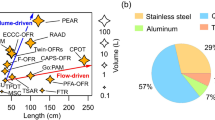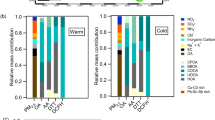Abstract
Emissions of volatile organic compounds (VOCs) and carbonyls from residential coal combustion of five coals with different maturities were studied in a simulated room. The coals were burned in form of honeycomb briquettes in a domestic coal stove, one of the most common fuel/stove combinations in China. Through a dilution system, VOCs and carbonyls samples were collected by canisters and silica-gel cartridges and analyzed by gas chromatography and mass spectrum (GC/MS) and high performance liquid chromatography/ultraviolet (HPLC/UV), respectively. The results show that the bituminous coals with medium volatile matter content produce the highest emissions while the anthracite yields the lowest. Among the identified carbonyls from the coal smoke, the aromatic compounds (benzaldehyde, 2, 5-dimethylbenzaldehyde and p-tolualdehyde, m/o-tolualdehyde, benzene, m, p-xylene and trimethyl-benzene) were relatively abundant, which might be due to the molecular structure of the coal. For formaldehyde, aromatic carbonyls and aliphatic alkanes, their concentrations increase up to the maximum values and then decrease with increasing coal maturity. The total carbonyls and VOCs have the same tendency, which was observed for the emission factors of organic carbon (OC), elemental carbon (EC), particulate matter (PM) and polycyclic aromatic hydrocarbons (PAHs) detected in the series study.
Similar content being viewed by others
References
Zhang J, Smith K R. Indoor air pollution from household fuel combustion in China: A review [C]// The 10th International Conference on. Indoor Air Quality and Climate, Beijing. 2005: 65–83.
Zhang J, Smith K R. Household air pollution from coal and biomass fuels in China: Measurements, health impacts, and interventions [J]. Environmental Health Perspectives, 2007, 115: 848–855.
Mumford J L, He X Z, Chapman R S, Cao S R, Harris D B, Li X M. Lung cancer and indoor air pollution in Xuanwei, China [J]. Science, 1987, 235(4785): 217–220.
Zhang J, Smith K R. Emissions of carbonyl compounds from various cookstoves in China [J]. Environmental Science and Technology, 1999, 33(14): 2311–2320.
Tsai S M, Zhang J, Smith K R, Ma Y, Rasmussen R A, Khalil M A K. Characterization of non-methane hydrocarbons emitted from various cookstoves used in China [J]. Environmental Science and Technology, 2003, 37(13): 2869–2877.
Chen Y J, Sheng G R, Bi X H, Feng Y L, Mai B X, Fu J M. Emission factors for carbonaceous particles and polycyclic aromatic hydrocarbons from residential coal combustion in China [J]. Environmental Science and Technology, 2005, 39(6): 1861–1867.
Chen Y J, Zhi G R, Feng Y L, Fu J M, Feng J Q, Sheng GY, Simoneit B R T. Measurement of emission factors for primary carbonaceous particles from residential raw-coal combustion in China [J]. Geophysical Research Letter, 2006, 33(20): 1–4.
Chen Y J, Mai B X, Sheng G R, Fu J M. Emission characterization of particulate/gaseous phases and size association for polycyclic aromatic hydrocarbons from residential coal combustion [J]. Fuel, 2004, 83(7–8): 781–790.
Feng Y L, Wen S, Wang X M, Sheng G Y, He Q S, Tang J H, Fu J M. Indoor and outdoor carbonyl compounds in the hotel ballrooms in Guangzhou, China [J]. Atmospheric Environment, 2004, 38(1): 103–112.
Feng Y L, Wen S, Chen Y J, Wang X M, Lu H X, Bi X H, Sheng G Y, Fu J M. Ambient levels of carbonyl compounds and their sources in Guangzhou, China [J]. Atmospheric Environment, 2005, 39(10): 1789–1800.
Solomon P R, Hamblen D G, Carangelo R M, Serio M A, Deshpande G V. General model of coal devolatilization [J]. Energy Fuels, 1988, 2(4): 405–422.
Cao Sou-ren. Coal-burning pollution and health [M]. Beijing: China Environmental Science Press, 1992: 6–11 (in Chinese).
Radke M, Schaefer R G, Leythaeuser D, Teichmuller M. Composition of soluble organic matter in coals: Relation to rank and liptinite fluorescence [J]. Geochimica et Cosmochimica Acta, 1980, 44(11): 1787–1800.
Author information
Authors and Affiliations
Corresponding author
Additional information
Communicated by WU Ming-hong
Project supported by the National Natural Science Foundation of China (Grant Nos.40773047, 40605033 and 40973071), the Shanghai Leading Academic Discipline Project (Grant No.S30109), and the Earmarked Foundation of the State Key Laboratory of Organic Geochemistry (Grant No.OGL-200705)
About this article
Cite this article
Feng, Yl., Xiong, B., Mu, Cc. et al. Emissions of volatile organic compounds and carbonyl compounds from residential coal combustion in China. J. Shanghai Univ.(Engl. Ed.) 14, 79–82 (2010). https://doi.org/10.1007/s11741-010-0201-3
Received:
Revised:
Published:
Issue Date:
DOI: https://doi.org/10.1007/s11741-010-0201-3




